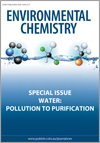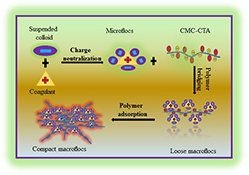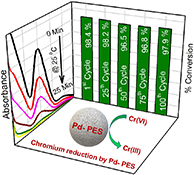
Environmental Chemistry
Volume 16 Number 8 2019
The International Conference on Water: From Pollution to Purification
Environmental context. Pesticide losses from land to surface waters have the potential to cause ecological damage. Furthermore, pesticides in surface waters present a major challenge for water companies accessing these waters for the domestic supply, in terms of complying with water quality regulations. Here, we evaluate the potential of field- and ditch-scale free-surface constructed wetland systems for reducing pesticide transfers from land to surface waters.
EN19014Fabrication of magnetic functionalised calix[4]arene composite for highly efficient and selective adsorption towards uranium(VI)
 and Shu-Ya He
and Shu-Ya He
Environmental context. Uranium-containing wastewaters have high potential to harm the environment and human health. We found that the combination of calix[4]arene with magnetic Fe3O4 particles produced good adsorption of uranium from wastewater. In addition, this material can be recycled and reused, so it has good prospects in practical applications for uranium remediation.
EN19049Multilayered surface for the interactive separation of perchlorate from aqueous medium
Environmental context. Perchlorate from rocket fuel plants or firework manufacturing units can seriously contaminate drinking water. We developed a separation skin on a microfiltration membrane and on sand that can remove perchlorate from water in the presence of competing ions. This method is suitable for a domestic water purification unit selective for perchlorate removal.

Environmental context. The fate and build-up of phosphate nutrients in aquatic environments is an urgent environmental problem affecting global water security. This study, guided by a statistical design method, optimises the flocculation properties of a biopolymer for removing orthophosphate from water. This improved technology has potential widespread applications for removal of orthophosphate from water and wastewater treatment systems.
Environmental context. Hydrochlorothiazide, a common diuretic pharmaceutical, occurs in environmental waters because current treatment technologies are unable to eliminate it from wastewater. To remove this environmentally hazardous chemical from water, we developed an advanced electrochemical oxidation process to efficiently degrade and mineralise the compound. Wider application of the process holds the promise of general, efficient destruction of pharmaceuticals in aqueous media.

Environmental context. Chromium, a carcinogenic metal present in the wastewater of several industries, is currently removed by treatment with large amounts of chemicals and expensive nano-catalysts. We have immobilised a nano-catalyst in tiny polymeric balls that are highly efficient at capturing chromium, and are easy to isolate for multiple reuse. Using our methodology, consumption of chemicals for removing chromium from wastewater is reduced by 97 %.
EN19126Fate of steroid hormone micropollutant estradiol in a hybrid magnetic ion exchange resin-nanofiltration process
Environmental context. Contamination of surface water by micropollutants is a major environmental concern because of their high persistence and toxicity. Micropollutants are only partially removed in nanofiltration water treatment systems, encouraging the investigation of more complex systems involving partitioning with membrane materials, organic matter and ion exchange resins. This study elucidates the micropollutant partitioning mechanisms in this complex water treatment system.
EN19113Microplastics in sediments and fish from the Red Sea coast at Jeddah (Saudi Arabia)
Environmental context. Millions of tons of plastic debris are present in the marine environment. This study addresses the issue of microplastics in nearshore sediment and fish sampled from the Saudi coastal waters of the Red Sea. The results show that the sediments of all analysed stations contained microplastics, and microplastic particles were detected in almost half of the 140 sampled fish.



